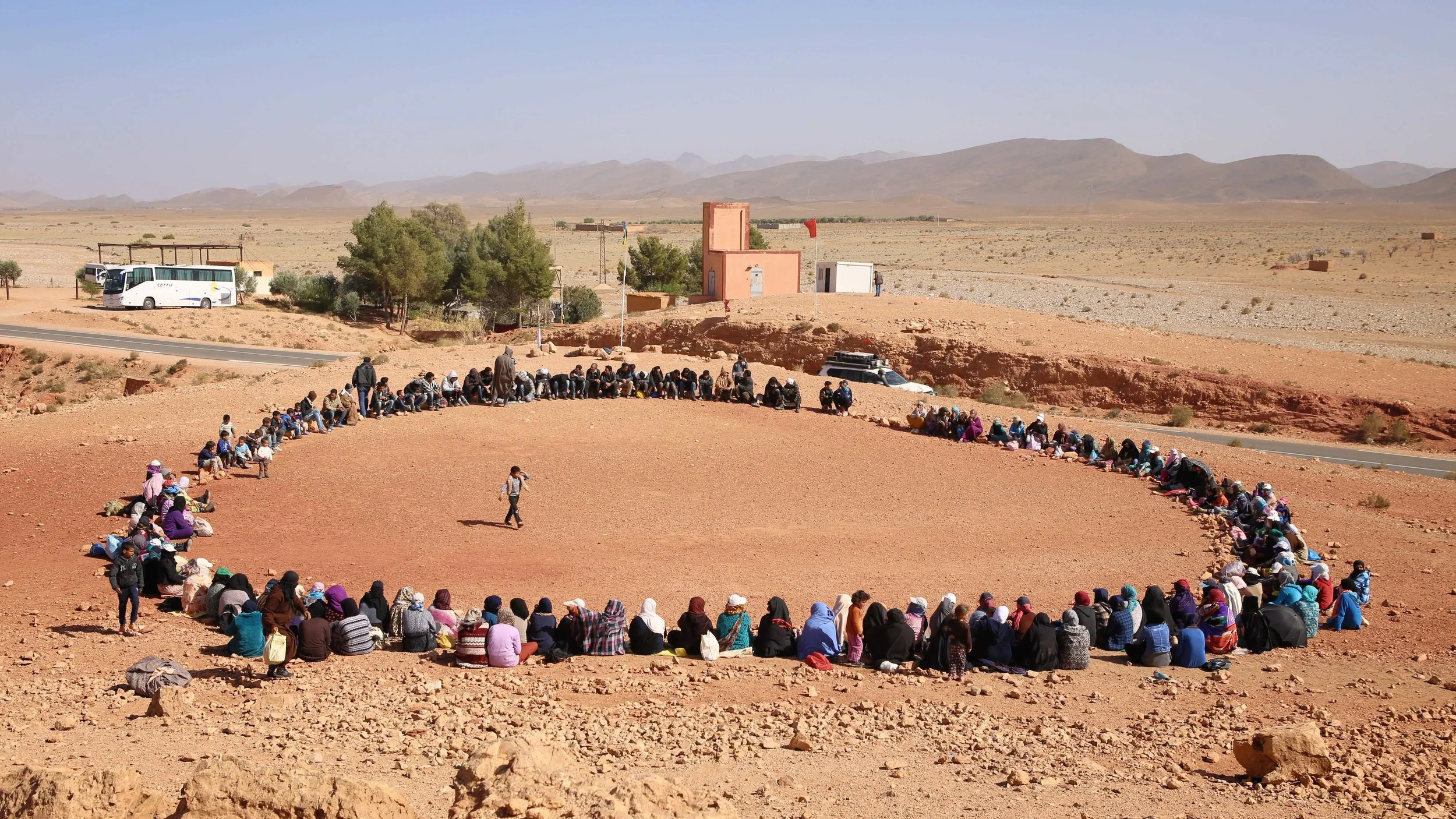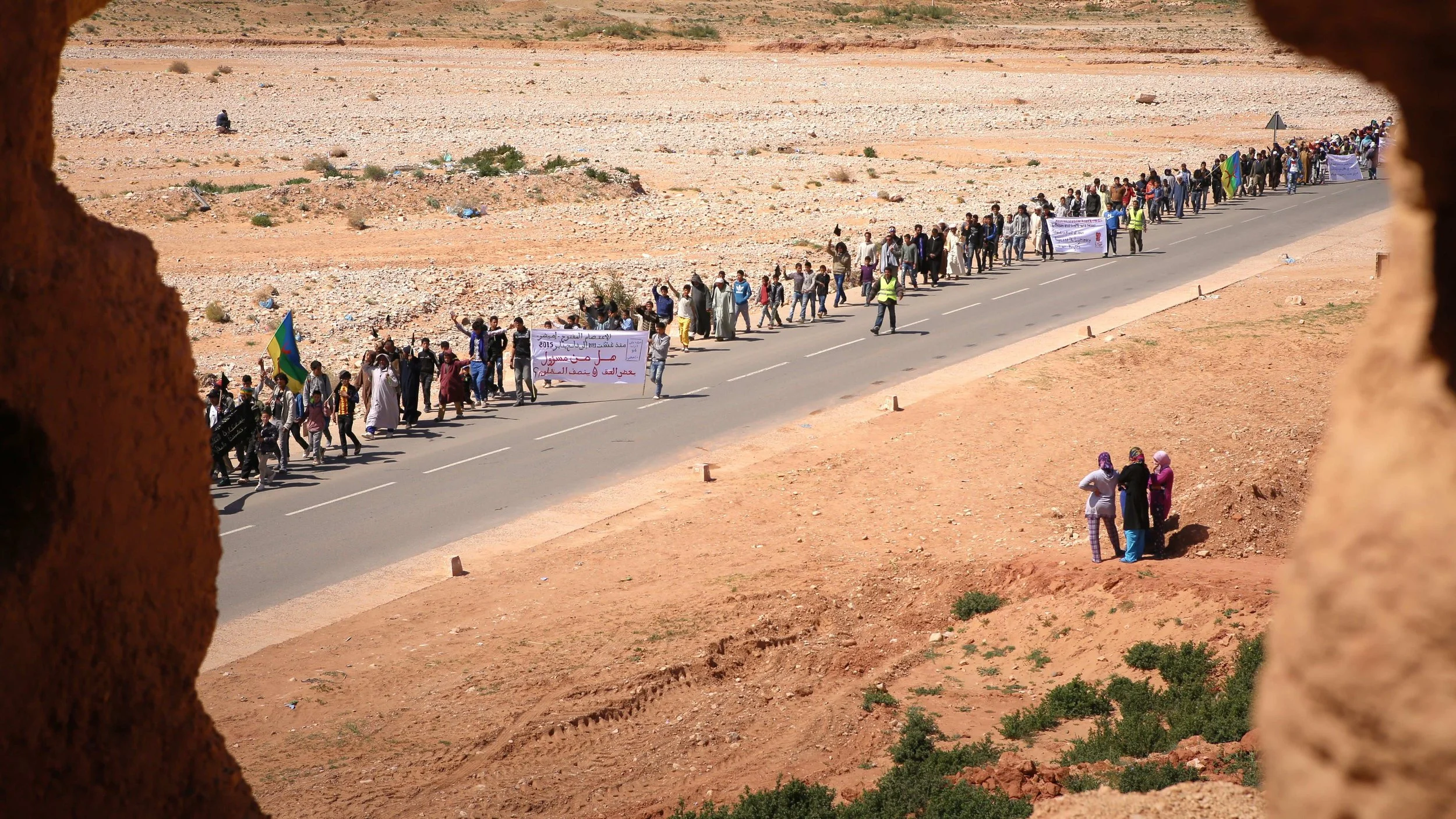Songs of a Wretched Earth: The Voice as Testimony in Film
By Jessica E M
Jessica E M is a writer, artist and curator with an interest in ecology, globalization and migration. She is a PhD candidate, exploring tools of cultural resistance amongst migrant agricultural workers, and is a facilitator of creative exchange between North Africa and Europe.
The Silences of the Palace, 1994 dir Moufida Tlatli
Bamako, 2006 dir Abderrahmane Sissako
Amussu, 2019 dir Nadir Bouhmouch
A girl, coming of age, takes to the stage in a Tunisian palace of men in bed with the French. In imagined court proceedings against the World Bank in Bamako, an old man, sitting in the audience after being denied the opportunity to testify on the stand, leaps to his feet. Clouds of sand roll across the landscape of a remote Moroccan village in the Sahara Desert to the thud of a drum.
And then, a voice pierces through the screen carrying a song.
In The Wretched of the Earth, Franz Fanon called for les damnés de la terre to rise up against colonialist violence and exploitation. He emphasised the importance of resource sovereignty, of having control over your own soil, sun and water. And although we may now criticize this as being overly humanistic, it still holds much relevance today. He warned of colonial rule being replaced by like-minded leaders, of the economic grip Europe was to have over post-colonial nations through trade deals, export deals and the sorts. The promise of true independence did not lie only in the political, but also in the land: land, bread and dignity. As Jennifer Wenzel highlights in her text Reading Fanon Reading Nature social structures and environmental conditions are inseparable - they seep into each other, with the ability to rot each other to the core.
The three striking scenes I describe above come from three very different films; a drama (The Silences of the Palace, 1994 dir Moufida Tlatli), a mockumentary (Bamako, 2006 dir Abderrahmane Sissako) and a documentary (Amussu, 2019 dir Nadir Bouhmouch) through which the inexorable links between colonialism, power and the land can be traced. They all sit at the edge of something, the first, the precipice of independence, the second, the fight for justice from colonial hangovers, and the latter a present day indigenous environmental movement. The voice, in all of the films, acts as a transmitter, cutting through the films’ visuals. A transmission which makes the hairs stand on the back of your neck, or maybe catches your breath.
Can the voice, in itself, be a form of testimony in this wretchedness?
Song in a Palace of Ghosts
(trigger warning SV and abortion)
Even the title of Moufida Tlatli’s 1994 masterpiece indicates the significance of the voice by evoking its absence. Set in the 60’s, the story of The Silences of the Palace is told through the memories of a young woman, Alia, that come to her in waves when she returns to the palace her mother worked in and where she grew up.
A patriarchal-colonial structure, the palace symbolizes the complicated chokehold of colonial mandates on a country. The beys, Tunisia’s monarchy, rule the palace, Alia’s whole world as well as the country, though they ultimately answer to the French protectorate. While the French may not have converted mosques to churches, or changed the official language as they did elsewhere in the Maghrib, they did settle their colonialists in the most fertile grounds in the north, and mined for phosphate in the south. During all of this colonialist resource extraction, the people remained subjects of the bey.
Set almost entirely within the confines of the bey’s palace, the film is an unflinching interrogation of class struggle within liberation, as well as women’s liberation within both, across two time periods. Though post-independence the building is almost deserted, as a young girl in the 50’s, the palace walls tyrannised and taught only silence.
Silence surrounding colonialism and the nationalist sentiment, which we gather through fleeting political radio broadcasts or a few stolen snippets of overheard conversations, was rising outside of the gates. The wordlessness of the sexual violence endured by her mother, and all the servants.The dangers of home abortions also shrouded in silence, witnessed only through sneaked glances around doors or through keyholes which one time plummets Alia into a refusal to speak.
Independence of the country gets wrapped up in notions of Alia’s, and in fact all the women's independence. But independence from what exactly? From her mother? Or from the palace? From unwanted pregnancy? Or even from the revolutionary lover, Lotfi, who like the nation state, goes on to fail her?
In the final flashback Alia interrupts an engagement party in the palace with a forbidden rebel’s anthem. While her mother is only seen singing labour songs in the kitchen with the other servants throughout the film, Alia sings upstairs, proud and in view. The song is able to lift her from the expected exploitation of her mother’s world, whilst also defying the social and political norms of the palace. However defiant and triumphant, her voice still exists within a structure that owns and objectifies her. Her future is as Fanon predicted, but it is in the way Tlatli tangles up independence with girlhood, with the filial bond and even the female body that renders Alia’s voice a testimony. It carries all of the experience of the women before her as well as the promise of what’s to come. “Like you, I have suffered," she says, speaking to her deceased mother as an adult in the final scene. Despite hoping that Lotfi, or the independence, would save her, her suffering has in fact mirrored her mother’s. Her voice is a ghost haunting the present. “My songs were stillborn” she says.
Song in a Court of Witnesses
Bamako is a political drama that puts the World Bank and the International Monetary Fund (IMF) on a staged trial in a courtyard in Mali, the lived space of the people affected by the offenders. Using real testimonies from ordinary people affected by these neocolonial institutions, the film blends documentary elements with fiction. As lawyers argue over the devastating economic impact of global financial institutions on African nations, daily life continues around the with real footage of children playing or women dying cloth, and fictional storylines of a singer migrating for work or a country western movie being shot. Rather than presenting a conventional legal drama, Bamako highlights the disconnect between the abstract policies of global finance and their real human consequences.
The testimonies hail from the likes of farmers, teachers and writers who describe the weight of the World Bank debt, and interference, in the country. One official reveals a confidential letter she received stating “that if we refuse to privatise the transport system, the World Bank will withdraw funding for education and health care in Mali.” It exposes the crippling reality of a system which gives food aid parcels with one hand and takes essential resources for health with another. As Fanon predicted, the global north once again finds a way to tighten its grip.
Through its very form, though, Sissako manages to bring into question the very concepts of testimony, justice and even discourse, through the sometimes satirical recreation of a judicial court of law and arduous legal proceedings, which even the villagers listening through the radio get bored with, and narrative threads which never seem to tie up.
When an elderly farmer, who earlier in the film is denied authority to give testimony on the stand for not following procedure, leaps out of his chair and cries, the people in the court listen, stunned. The villagers not present quickly tune their attention back to the radio. In the Malian language of Bambara, we hear this man’s wailing song as his testimony. Presented without subtitles, the sanctity of his song remains, not losing any meaning in attempted translation.
For the (very real) people taking part in the film, as well as the viewers of it around the world, the song is a form of testimony that not only offers an opportunity to hear an account of something that happened, but of actually bearing witness yourself. Its pitch and rhythm is something to be felt; the song, the cry, the wail, is an event in itself. Sissasko artfully undermines the very structure of a court, as well as the structure of a film, challenging the temporality and spatiality inherited from colonialism and imperialism, questioning if, or how, we can even hear a testimony such as this man’s song.
Song in a Mine of Silver
The documentary, Amussu, was collectively made with the Amazigh people of Imider, Morocco, who protest against Africa's largest silver mine. The movement spans decades since the mines’ opening, and the villagers have used song as a way of passing down their resistance poems to archive their struggle as well as keep it alive.
An example of the extractivist logic of capitalism, a foundation of colonial ideology, the film again raises questions of class, but also ethnicity and the rights of land within liberation. The very act of mining affects every planetary plane; the land that it unearths, the air that it infiltrates with toxic waste treatment, the water that it swallows up and the society which, at a local level, see no wealth distribution from it.
Fanon speaks of the soil as something that must be reclaimed—not just for economic survival, but for the restoration of identity and dignity. The villagers’ song in Amussu echoes this sentiment: their voices rise not only in protest but in a declaration of belonging to, and upholding their connection to the land.
Once a week, hundreds of men, women and children climb to the camp atop the mountain to take part in assemblies to verbally articulate the struggle, renew alliances and uphold their commitment to the cause. Women are forced to search for water in drying wells, mourn the disappearing plants they harvest, miss their imprisoned sons and worry for their unemployed husbands and brothers. On a long, slow, up-shot of an almond tree in bloom, stoic in a clear blue sky, a faceless voice sings a tune. It is un-subtitled until the voice says “Reply to my verse!” and we feel as though the tree might reply. To tell the story of its years without leaves, of its fight to remain in a lush green oasis rather than meet its inevitable fate in the furnace. Would this be the testimony of the tree if, in 2011, the movement had not managed to close a water valve which reduced the productivity of the mine by 40%?
When the villagers sit in a circle and sing, it is not merely an act of protest— but of testimony and preservation, passed from generation to generation, as rooted and steadfast as the tree but also as vulnerable. A waiting game of who, or what, can last longer: the mine or the villagers? The sliver or the water? The song or the younger generations who have to leave to find work?
As the Amazigh proverb from Imider says: An event without its poem never happened. By singing their poems, they insist on existence.




